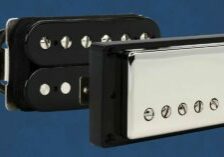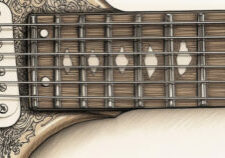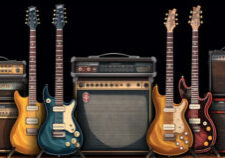I know what you’re thinking: ‘Another article about guitar gear? Do we really need to dive into the nitty-gritty of every component?’ But hear me out, as we’ll answer the question: what dooes a preamp do? The simple answer is that it helps you achieve a killer sound.
As an avid guitar player myself, I can attest to the fact that the preamp is a game-changer in shaping the tone and adding character to your playing. So, let’s dive into the details and uncover all the ways a guitar preamp can enhance your playing.
What Does A PreAmp Do on a Guitar Amp?
A guitar preamp is a device that is designed to amplify the weak electrical signal that is generated by the guitar’s pickups. The pickups on a guitar convert the vibrations of the strings into an electrical signal, but this signal is typically very weak and requires amplification before it can be sent to an amplifier or other audio equipment.
A preamp can be built into the guitar itself, as is the case with many acoustic-electric guitars, or it can be a separate device that is used with an electric guitar. The preamp typically includes a series of controls that allow the player to adjust the tone and volume of the instrument. These controls can include bass, midrange, and treble equalization, as well as gain and volume controls.
There are many different types of guitar preamps available, including tube and solid-state models. Tube preamps are known for their warm, natural sound, while solid-state preamps offer greater reliability and durability. Some guitar preamps also include built-in effects, such as distortion, reverb, and chorus, which can be used to create a wider range of sounds and tones.
Building Blocks of the Sound Signal Chain of an Electric Guitar & Amp
Exploring the signal chain of an electric guitar reveals the crucial components responsible for shaping your sound, allowing you to understand the intricacies of your gear and ultimately achieve your desired tone. Here is the basic signal chain for an electric guitar
- Guitar
- String vibration
- Pickups will “pick up” the vibrations
- Most of the time the sound goes through pedals
- Then into the guitar amp input – The preamp
- The power amp that amplifies the sound
- Out to the combo amp speakers or speaker cabinet
- Into a microphone (if recording)
- Into an direct interface to convert analog signal to digital signal (if recording)
- Into a comptuer
- Into your DAW software program including amp and effects plugins
What is the Power Amp Do on a Guitar Amp?
The power amp takes the low-level signal from the preamp and boosts it to a higher level that can power the speakers and produce the sound that we hear. The power amp comes located after the preamp in the signal chain and responsible for controlling the overall output level of the amplifier.
Many amps will only have a volume control at the power amp level but more advanced and expensive amps will have additional controls to shape tone such as a presence, resonance and bias control. There are different types of power amps used in guitar amplifiers, including tube amps, solid-state amps, and hybrid amps. Each type of power amp has its own unique characteristics that affect the tone and overall sound of the amplifier.
The power amp is an essential part of the guitar amplifier, as it is responsible for delivering the power to the speakers that produce the sound. Without a power amp, the signal from the preamp would be too weak to drive the speakers, and the guitar amplifier would not be able to produce any sound.
Frequency Response and Tone Shaping
Did you know that EQ controls play a big role in frequency response? In fact, 80% of tone shaping happens in the midrange frequencies. This means that the EQ controls on your preamp can have a huge impact on your tone.
When adjusting your preamp’s EQ controls, it’s important to understand which frequencies they affect. Bass controls usually affect frequencies below 200 Hz, while treble controls focus on frequencies above 2 kHz. Midrange controls are where most of the tone shaping happens, affecting frequencies between 200 Hz and 2 kHz. By manipulating these frequencies, you can create a wide range of tones, from warm and mellow to bright and cutting.
To get the most out of your preamp’s EQ controls, experiment with different settings and listen carefully to how they affect your tone. Try boosting or cutting different frequencies to see how it affects your sound, and don’t be afraid to push the limits of what your preamp can do. With a little experimentation, you can find the perfect preamp settings for your playing style and achieve the tone you’ve been dreaming of.
Adding Effects with a Preamp
You can add effects to your signal chain either before or after the preamp. If your amp has a send and return effects loop then those are the connections that allow you to add effects after the preamp and before the power amp. Its very common to come out of your send output into a delay pedal into a reverb pedal and then back out to the return. This puts those effects after the preamp and often creates a more pleasant tone than using the delay and reverb before the preamp.
You can try effects in various locations. For example, placing a wah pedal before the preamp can produce a more aggressive tone, while placing it after the preamp can produce a smoother, more controlled sound. Similarly, placing a chorus pedal before the preamp can produce a more subtle, atmospheric effect while placing it after the preamp can produce a more pronounced, detuned effect.
Ultimately, the ability to add effects through a preamp provides endless possibilities for sound experimentation and expression. With the right combination of pedals and placement, you can create a unique signature sound that sets you apart from other guitarists. So don’t be afraid to experiment and explore the sonic possibilities that a preamp can offer.
External Preamp Pedals and Rack Units
Now that we’ve discussed the benefits of using preamp pedals to add effects to your guitar sound, let’s explore the world of external preamp pedals and rack units. These devices can be a game-changer for for guitarists and bassists who want to achieve a signature sound without the hassle of carrying around bulky equipment.
Though most amps come with the preamp and power amp in one unit, you can actually buy a preamp and power amp separately. They come in a small preamp head, rack units and even preamp pedals. They are designed to emulate the sound of specific amplifiers These separate preamps are often an affordable way to make your amp sound like a highly desirable amp without having to buy the entire amp.
For example, I have a preamp for a Mesa Boogie Mark IIC+ which is a very rare and expensive amp. But I use this preamp and connect to the power amp of my Friedman amp head. Some preamps are also designed to work well with different styles of music, so it’s worth doing some research to find the right preamp for your needs. One of the more popular preamp pedals is the Strymon Iridium which has 3 amp models and IR cab simulator.
External preamp pedals operate similarly to the preamp section of a guitar amplifier, providing gain and EQ shaping before the power amp and speaker. These pedals can range from simple, single-channel designs to complex, multi-channel units with extensive EQ controls.
Rack-mounted preamp units offer even more versatility, allowing for easy integration with other rack-mounted gear and offering a wider range of features and controls.
Differences between Tube and Solid-State Preamps
If you’re wondering which type of preamp to choose, it’s worth noting that tube preamps offer a warmer, more organic sound, while solid-state preamps provide cleaner, more precise tones. This difference is due to the way each type of preamp amplifies the signal.
Tube preamps use vacuum tubes to amplify the signal, which can add a subtle distortion and saturation to the sound. Solid-state preamps, on the other hand, use transistors to amplify the signal, resulting in a more transparent and accurate representation of the sound.
While tube preamps may offer a more desirable sound to some, they do have their drawbacks. They require more maintenance and are more fragile than solid-state preamps. Tube preamps also tend to be more expensive than solid-state preamps.
Solid-state preamps, on the other hand, are more reliable and durable, and tend to be more affordable. They also offer more consistent performance, as the sound doesn’t change as the tubes age.
In the end, the choice between a tube preamp and a solid-state preamp comes down to personal preference and the type of sound you’re looking for. It’s important to try out both types of preamps and listen to the differences for yourself before making a decision.
Keep in mind that your choice of preamp can greatly affect your overall tone, so it’s worth investing in a high-quality preamp that suits your needs.
Choosing the Right Preamp for Your Needs
Choosing the right preamp for your needs is definitely not important, unless you enjoy terrible tone and sounding like a beginner. As with any piece of gear, it’s crucial to consider your specific needs and preferences. Some preamps may have more gain than you require, while others may not offer enough tonal shaping options. Before making a purchase, take the time to research and compare different models to ensure you find the right fit.
To aid in your search, consider creating a table to compare various preamps based on key features. For example, you may want to compare the number of channels, the type of EQ controls available, and whether the preamp has built-in effects. Other important factors to consider include the price, the size and weight of the unit, and the overall build quality. By creating a detailed comparison chart, you’ll be able to make an informed decision and find a preamp that meets all of your needs.
It’s also worth considering the type of music you play and the venues you typically perform in when selecting a preamp. If you play in a loud rock band, a preamp with plenty of gain and distortion options may be ideal. On the other hand, if you primarily play acoustic guitar in smaller venues, a preamp with a natural, transparent tone may be a better choice. Ultimately, the right preamp for you will depend on your individual needs and preferences, so take the time to research and compare options before making a purchase.
Tips and Tricks for Optimizing Your Preamp Settings
It’s crucial to optimize your preamp settings in order to achieve your desired tone and get the most out of your gear. Here are some tips and tricks to help you do just that:
- Experiment with different EQ settings: Your preamp’s EQ controls are there for a reason, so don’t be afraid to use them. Try boosting or cutting different frequencies to see how they affect your tone. You might be surprised at what you can achieve with just a few tweaks.
- Pay attention to gain staging: Gain staging refers to the process of setting the levels of your various components in order to achieve the best possible sound. In the case of preamps, it’s important to make sure you’re not overdriving the signal. This can lead to unwanted distortion and a loss of clarity. Experiment with different gain settings to find the sweet spot for your setup.
- Consider using a boost pedal: A boost pedal can be a great way to give your preamp a little extra kick. By adding extra gain before the preamp, you can push it into overdrive more easily and achieve a more aggressive tone. Just be careful not to overdo it, as too much gain can lead to unwanted noise and feedback.
By taking the time to optimize your preamp settings, you can unlock a whole new world of tonal possibilities. Don’t be afraid to experiment and try new things – you never know what you might discover!
Conclusion
In conclusion, a guitar preamp is a vital component in achieving a signature sound. It boosts the electrical signal of the guitar, allowing for the first stage of amplification and frequency response shaping. It also offers the ability to add effects and reshape tonal characteristics, making it a valuable tool for gigging and recording artists alike.
Symbolically, a guitar preamp can be seen as the heart of an electric guitar rig, pumping life into the sound and giving it the energy to move the speaker coil. Without a preamp, the signal would be weak and lifeless, lacking the richness and complexity that defines a great guitar sound.
As such, investing in a good preamp pedal can expand tonal possibilities and offer sound consistency, ensuring that every performance or recording session is a success. In the end, the choice of preamp will depend on individual needs and preferences. However, by understanding the basics of preamp functionality and placement in the signal chain, guitar players can optimize their sound and achieve the full potential of their instrument.
With a good preamp by their side, they can create music that speaks to the soul and moves the heart.





